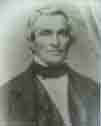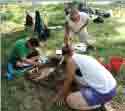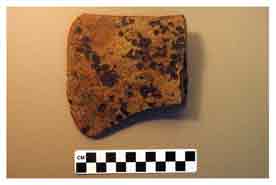
John P. Pettijohn Sr., his family, and companions Joseph Price and Augustus Friend were among the first European settlers in this part of Missouri. The group left Ohio on a keelboat and came down the Ohio and Mississippi rivers to the White River. Escott (1878) and Holcomb (1883) both date their arrival in the White River basin to 1818. They encountered floods, illness, and near starvation on their journey up the White River. Some of their party continued as far as the "Jeems" (James River), erecting a cabin about eight miles south of the present site of Springfield. "On his return from one of these expeditions, William Pettijohn told his neighbors on the White River that he had discovered the country which flowed with milk and honey, bear’s oil and buffalo marrow" (Holcombe 1883:129). After Missouri attained statehood in 1821, Pettijohn and others in his group moved to the area near the confluence of Wilson Creek and the James River. One of his sons, John Pettijohn Jr., settled in Section 18, Township 27 North (T27N), Range 22 West (R22W), near what became known as the Berry Gibson place and Gibson Cemetery.

Dr. Terrell's bill for treatment of James Wilson, 1834, James Wilson probate file, Greene County Archives.
The land was ceded to the Delaware Indians by treaty shortly after Pettijohn settled here. The Pettijohns and a number of other pioneers in the area gave up their claims to the land and moved. Mr. Pettijohn and his sons went back to Ohio, but he and his son John returned to their old home site(s) after the Delaware removal to the Kansas City area in 1830-1831. In their absence, the Delaware had resided in the area Where the Wilson Meets the James, giving the area the name “Delaware Town” (Holcombe 1883:134). Upon their return, they found that the land they had settled in the early 1820s was occupied by Joseph Porter. Pettijohns moved on, settling further down the James River.
Joseph Porter, said to have trapped the last beaver in Greene County, was a successful farmer, trapper, and fisherman. Porter was originally from Virginia. He moved to Tennessee in 1812 and subsequently migrated to Missouri in the early 1830s. According to Mrs. Ralph Dennison, a 6th generation direct descendant, land was taken over by Porter "…who ‘bought’ them (improvements by Pettijohn or subsequent trading-post owners) from [the] Delaware for [an] undetermined sum. Shown on [the] 1835 plat map as Mr. Porter’s field, [the] old Delaware trail crossed about where Gibson Cemetery is today" (Fuller 1978). The name of Joseph Porter is found on the 1833 Greene County tax list. A land patent for 40 acres in Section 13 in T27N R22W was issued to Porter in 1843. Another patent was issued to Porter in 1848 for 168.37 acres in Section 18. The latter patent is marked "preemption," meaning Porter had settled on the land before the official government land surveys were undertaken in 1835. Joseph Porter died on December 18, 1858 and was buried in Delaware Town Cemetery (23CN164). Porter Township, now a part of Christian County, bears his name.
The location of Porter’s dwelling and presumably other outbuildings, some or all of which may have been erected during the Delaware period, has been identified as archaeological site 23CN3 (Fuller 1978). A historic foundation that may date to the early nineteenth century occurs at this location (Rees et al. 2000:35). Artifacts from this site that may be from this early period of European settlement include a hand-forged axe head, stoneware pottery sherds, and a black glass marble. Gibson Cemetery, a "pioneer cemetery" containing 25 gravestones dating from 1850 to 1900, is also part of site 23CN3 (Fuller 1978; Rees and Powell 2000).
Other early European settlers in the area included James Wilson, for whom Wilson Creek is named; his widow Elizabeth Wilson Terrell and William Dye, who together operated Bell Tavern during at least the mid-to-late 1830s; and friends Dr. Cornelius Terrell and Littleberry Hendrick. Elizabeth Terrell is a central character in the early story of the area Where the Wilson Meets the James. James Wilson had been "married" to three Indian women while operating his trading post near the mouth of Wilson Creek during the 1820s. About the time the Delaware left southwest Missouri (1830) he went to St. Louis and returned with Elizabeth. Early documents referred to her as "Wilson’s French wife."
James and Elizabeth briefly managed a farm in the location of the old trading post. Unfortunately, James Wilson became ill only a few years after their marriage. During his illness he was treated by Dr. Cornelius Terrell, who moved to the Delaware Town area with his friend, Littleberry Hendrick. Wilson’s probate records show a receipt for May 28 and May 29, 1834 for Dr. Terrell’s visits to attend James Wilson. He charged $5.00 for each visit, and $1.50 for medicine, a pint of French brandy, 2 lbs of sugar, and 4 oz of tea. He visited again in the night on May 30, charging $.50 each to bleed Mrs. Wilson and a "negro," in addition to James Wilson’s treatment. James Wilson died shortly afterward. The estate was billed in June of 1834 for $6.00 by Sydney S. Ingram for "making one Raised Top Coffin." On June 7, 1834, John D. Shannon was appointed administrator of James Wilson’s estate. In the document establishing him as administrator, Elizabeth states:

Elizabeth Wilson appoints John D. Shannon to settle her husband's estate, 1834, James Wilson Probate file, Greene County Archives.
"... as I have made choice of him to attend to the Business for me as I do not wish to undertake my self nor am I in a situation to attend Court at this time therefore wish you to grant Letters Testamentary at this court to Mr. Shannon as it is important the matter should be attended to before the next court by your compliance with this request will confer a singular favor on me etc., etc.
Elizabeth Wilson"
Her neighbor Joseph Porter witnessed the document. After James Wilson’s death, Elizabeth went into business with William Dye. Together, they operated what became known as Bell Tavern, which was probably the same place as the former trading post. This has been the site of extensive archaeological research by the Missouri State University Archaeology Field School and is associated with the Cherokee Trail of Tears.

Photo of Littleberry Hendricks, courtesy Greene County Archives.
Elizabeth Wilson married Dr. Cornelius Terrell in April 1835. Dr. Terrell emigrated to Greene County with Littleberry Hendrick in 1833-34 and his name appears on the 1834 county tax list. Terrell Creek, a major tributary of lower Wilson Creek, bears his name. He was the attending physician during James Wilson’s last illness. Dr. Terrell became the second Circuit Court Clerk for Greene County in 1835, or the same year that he married Elizabeth Wilson. The 1840 Census lists a boy under the age of five in the Terrell household. This boy was apparently a child of Cornelius and Elizabeth. The census also lists two boys ages 5-10, one boy 10-15, one male 20-30, one female 20-30 (Elizabeth), and one male 30-40 (Dr. Terrell). It isn’t clear to whom the other children belonged. Dr. Terrell continued to practice medicine in Greene County and held the position of County Clerk until 1839. It appears the family may have lived in Springfield part of the time after their marriage. Terrell sold lots he owned in Springfield in 1839 and 1840. They then moved to Taney County, Missouri (Rising 2005). Dr. Terrell died in late 1840. The last document referencing Elizabeth Wilson Terrell is a Certificate of Land Patent issued in 1848 to John S. Waddle, assignee of Elizabeth Terrell. The patent pertains to 80 acres in Section 1 of T27N R23W. This includes the site of Bell Tavern and a nearby cemetery known as Wilson Cemetery.
Littleberry Hendrick also patented 160 acres in Section 1 of T27N R23W, land that occurred immediately west of Elizabeth Terrell’s property. As stated, he and Dr. Terrell were friends. Mr. Hendrick came to Greene County in 1833, the year Greene County was organized. The first term of the county’s Circuit Court was held on August 12, 1833. One item of business transacted during this term was the admittance of Littleberry Hendrick to practice as an attorney. He ran for County Justice in 1834 and Lieutenant Governor in 1848. He died of a fever in Springfield in January 1863, only two days after the Civil War Battle of Springfield.

Field School 2007, unit excavation at Elizabeth Wilsons Terrell's home.
Archaeological field research in the area has resulted in the recovery of numerous artifacts dating to this time period. Hand-painted pearlware ceramics, table utensils, cut square nails, and bottle and flat glass are common artifacts related to the households of the families that settled around the confluence of Wilson Creek and the James River.


